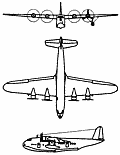 |
Short S.23 Empire1936 |  |
| PASSENGER FLYING BOAT | Virtual Aircraft Museum / United Kingdom / Short |
 |
In 1935 the British government took the bold decision to carry all mail within the Empire at the ordinary surface rate (in Britain then equal to 0.625 p). Combined with.increasing passenger traffic, this called for a sudden expansion of Imperial Airways and the equally bold decision was taken to buy 28 of a totally new flying-boat 'off the drawing board' from Short Brothers. Flying-boats were then favoured because they could be more heavily loaded than landplanes, the latter being constricted by the small and rough fields available. The prototype S.23 made its very successful maiden flight on 4 July 1936. It was named Canopus and all sister-ships had names beginning with C, the boats also being known as the C class. Features included light-alloy stressed-skin construction; a cantilever high wing with electric Gouge flaps; four 685êW Bristol Pegasus Xc radial engines driving DH Hamilton two-position propellers; and a streamlined nose incorporating an enclosed flight deck for captain, first officer, navigator and flight clerk. A steward's pantry was amidships and in the normal configuration seats were arranged in front and rear cabins for 24 passengers. On long hauls sleeping accommodation was provided for 16, with a promenade lounge. On some routes experience showed that the mail capacity had to be raised from 1.5 to 2 tonnes, reducing the passenger seats to 17. All 28 were delivered, plus three for Qantas (Australia). Two were long-range boats with increased weight and transatlantic range. Eleven S.30s (eight for Imperial and three for Tasman Empire Airways) had 663kW Perseus XIIc sleeve-valve engines and greater range - the first four also being equipped for flight refuelling to greater weight. The final two boats were S.33s with increased weight and Pegasus engines. During World War II most of these great aircraft served on long routes all over the world. Four were impressed for RAF use with radar (two being destroyed in Norway in May 1940) and most were re-engined with the same 752kW Pegasus 22 engines as the Sunderlands (the derived military version). Their achievements were amazing: one made 442 crossings of the Tasman Sea, two evacuated 469 troops from Crete and one was flown out of a small river in the Belgian Congo in 1940. Others maintained schedules on the North Atlantic, between Britain and Africa, the dangerous Mediterranean route from Gibraltar to Malta and Cairo, and the Horseshoe route between Australia, India and South Africa. Most were retired in 1947

|  COMPANY PROFILE | |||||||||||||||||||||||||||||||||||||||||||||||||||||||||||||||
 |

|

